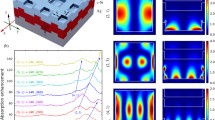Abstract
Metallic nanostructures can exhibit different optical properties compared to bulk materials mainly depending on their shape, size, and separation. We present the results of an optical modeling study on ordered arrays of aluminum (Al) nanorods with a hexagonal periodic geometry placed on an Al thin film. We used a finite-difference time-domain (FDTD) method to solve the Maxwell’s equations and predict the reflectance of the nanorod arrays. The thickness of the base Al film was set to 100 nm, and diameter, height and nanorod center-to-center periodicity were varied. Incident light in the FDTD simulations was an EM-circular polarized plane wave and reflectance profiles were calculated in the wavelength range 200-1800 nm. In addition, we calculated spatial electric field intensity distributions around the nanorods for wavelengths 300, 500, and 700 nm. Our results show that average reflectance of Al nanorods can drop down to as low as ∼50%, which is significantly lower than the ∼90% reflectance of conventional flat Al film at similar wavelengths. In addition to the overall decrease in reflectance, Al nanorod arrays manifest multiple resonant modes (higher-order modes) indicated by several dips in their reflectance spectrums (i.e. multiple attenuation peaks in their absorption profiles). Positions of these dips in the reflectance spectrum and spatial EM field distribution vary with nanorod height and diameter. Multiple reflectance peaks are explained by cavity resonator effects. Spatial EM field distribution profiles indicate enhanced light trapping among the nanorods, which can be useful especially in optoelectronic and solar cell applications.
Similar content being viewed by others
References
V.E. Ferry, A. Polman, H.A. Atwater: Acs Nano 12, 10055–10064 (2011)
S.A. Maier: Plasmonics: Fundamentals and Applications (springer - 2007) pp.77–80
K. Tanabe: J. Phys. Chem. C 112, 15721–15728 (2008)
H.A. Atwater, A. Polman: Nature Materials 9, 205–213 (2010)
A J Hughes,D Jones and A H Lettington: J. Phys. c (Solid St. Phys.) 2, 102–103 (1969)
Y. Ekinci, H.H. Solak, J.F. Loffler: J. Appl. Phys. 104, 083107 (2008)
Z. Liu, Y. Wang, J. Yao, H. Lee, W. Srituravanich, X. Zhang: Nano Lett.9, 462–466 (2009)
K. Ueno, H. Misawa: Bull. Chem. Soc. Jpn. 85, 843–853 (2012)
M.A. Sefunc, A.K. Okyay, H.V. Demir: Appl. Phys. Lett. 98, 093117 (2011)
Author information
Authors and Affiliations
Rights and permissions
About this article
Cite this article
Abdulrahman, R.B., Alagoz, A.S. & Karabacak, T. Enhanced Light Trapping in Periodic Aluminum Nanorod Arrays as Cavity Resonator. MRS Online Proceedings Library 1566, 3 (2013). https://doi.org/10.1557/opl.2013.878
Published:
DOI: https://doi.org/10.1557/opl.2013.878



